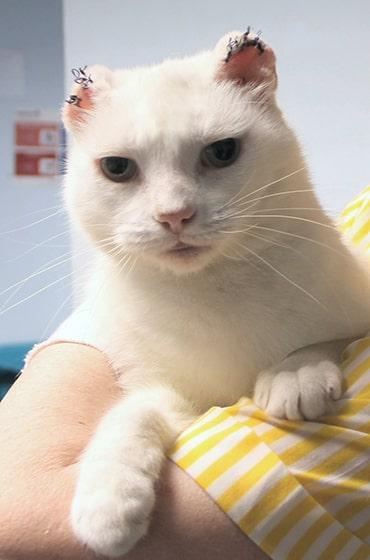Cat skin cancer : Squamous Cell Carcinoma

Overview
- One kind of skin cancer brought on by sun exposure is called squamous cell carcinoma (SCC).
It usually appears on the nose, eyelids, and tips of the ears. - Compared to cats of darker coloring, white cats are 13 times more likely to get a sunburn and to get an SCC.
- Cats older than five are more likely to get SCC.
- Frequently, it begins as a crusty area that resembles a cut or scratch.
- SCC typically affects many sites, such as the nose and ears, although it seldom spreads to the rest of the body.
- Treatment for SCC is best achieved by radiation therapy or excision.
- Read on to learn how to keep your cat from becoming sunburned—prevention is always preferable to treatment.
What is a squamous cell carcinoma?
One type of skin cancer is squamous cell carcinoma. Although it can affect any portion of your cat's skin, the hairless parts with the least amount of protection from sunlight—the ears, nose, or eyelids—are the most prone to develop it.
Due to their skin's increased sensitivity to UV rays, white cats, ginger cats, and cats with light colored skin are far more likely to get SCC. Since SCC takes months to years to develop, older cats—typically those over five years old—are far more likely to be affected.
Thankfully, SCC frequently spreads extremely slowly throughout the rest of the body.
Symptoms
- Often develop on the ears, nose or eyelids
- Scabs
- Small, black, crusty patches of skin
- Weepy, raw looking skin
- Red, raised areas of skin
- Non-healing wounds or ulcerated areas
- SCC patches tend to get worse in the summer and improve in the winter
- Nearly half of cats diagnosed with SCC have more than one cancer lesion – look carefully for others.
Causes
UV light is the most prevalent cause of squamous cell carcinoma because it destroys cells and can cause cancer.
Treatment options
The course of treatment for your cat's cancer will depend on the location, size, and extent of the disease. If the cancer is tiny, detected early, and hasn't spread across the body, treatment is always simpler.
Surgery
Your veterinarian might be able to remove the cancer from your cat if it is tiny and in an easy-to-operate area. Removal might not be a possibility if your cat's cancer is huge or located in a difficult-to-operate place.
Removing tumors from the nose and eyelids is typically more challenging than doing so from the ears. Your veterinarian may advise removing all or a portion of your cat's ear, a procedure known as a pinnectomy, if the cat has SCC on one or more of the ear tips. Although it may take some getting accustomed to, removing the ears can solve the issue if they are the only part afflicted and they won't lose their hearing.
Cryosurgery
When a cancer cannot be removed because it is located in an uncomfortable area, cryosurgery is a beneficial technique that uses extremely low temperatures to freeze and destroy cancer cells.
Specialist referral
If your cat's cancer is extensive or located in a difficult-to-treat area, your veterinarian could decide to refer them to a specialist. Other methods that a specialist veterinarian may choose to employ include photodynamic therapy, radiation, or a combination of these treatments.
Medication
There isn’t a medicine that specifically treats SCC. To help with symptoms, your vet may decide to prescribe pain relief, anti-inflammatory medicine and, in some cases, antibiotics.
Ongoing care and outlook
It’s likely your cat will recover well if their cancer is caught early and can be removed completely. Unfortunately, it may regrow if it can’t be removed completely.
New cancers might not always be visible to the naked eye, so it’s important to keep checking your cat, even after treatment. There is a chance your cat could develop another SCC later in life, so keep checking them and make sure they stay protected from the sun to prevent more cancers forming.
If your cat has a large cancer that can’t be treated you will need to monitor them closely to make sure they stay comfortable and receive the care they need. If your cat’s cancer is affecting their quality of life, it may be necessary to consider the difficult decision to put them to sleep.
Prevention
Protect your cat’s exposed skin by applying a waterproof sunblock (factor 30 or above) every day. Alternatively, protect your cat from intense sunlight by keeping them inside, especially around the middle of the day.
SCC in the mouth
Within the mouth, squamous cell carcinomas can manifest in a particular form. Regrettably, this kind of cancer is quite aggressive and frequently spreads to the face's bones. Major surgery may be required as part of the complex treatment. When deciding what to do, it's critical to take your cat's quality of life into account. If your cat's quality of life is poor, you might need to think about putting them to sleep. Ask your veterinarian for more guidance.
When to contact your vet
If you see any issues with your cat's skin, get in touch with your veterinarian. Your cat's odds of receiving a successful diagnosis and making a full recovery are higher the earlier you get them diagnosed.
You know your cat best. If you are concerned, it’s always best to contact your vet.



